Historical Impact Assessment (HIA) for Flood in Sudan#
In 2023, the Sudan Red Crescent (SRCS), German Red Cross (GRC), the Red Cross Red Crescent Climate Center (RCRCCC) and the Heidelberg Institute for Geoinformation Technology (HeiGIT) worked on an Early Action Protocol (EAP) for riverine floods along the River Nile in Sudan. One of the fundamental tasks while working on an EAP is to conduct a Historical Impact Assessment (HIA), for the particular hazard. The team of HeiGIT was responsible for this particular task and this article will tell the story of how they tackled the task. Due to the outbreak of hostilities in Sudan in 2023, the team could only rely on public data from the internet and some reports and data provided by SRCS. By the end of 2023, the team had collected, 3.204 rows of data from 60 sources, covering the timeframe from 2012 to 2023.
Why is a Historical Impact Assessment (HIA) Important?#
A HIA has two purposes. First, understanding in detail what kind of problems are caused by a particular hazard, allows people to make informed decisions on the selection of early actions to counter those problems. Secondly, without a good understanding of which magnitude of flood causes significant humanitarian impact, one can not adjust trigger levels accordingly to tackle those significant events.
Task#
Conduct an HIA to gain a detailed understanding of the impact of past flood events on the highest spatial and temporal resolution possible.
Challenges#
What were the main problems and challenges we faced while conducting the HIA?
Challenge 1: Scattered information on flood impacts
The one BIG challenge in this case was that there are no good datasets on flood impacts in Sudan. Practically, all information is scattered across a huge number of reports, maps, tables, dashboards and newspaper articles. Such documents can be found for example on ReliefWeb.
Challenge 2: How to get diverse data in one easy-to-use data format
Since all information about flood impacts is contained in such a diverse range of documents and formats, it is difficult to bring the information together in one dataset.
Challenge 3: Differentiating between riverine flood impacts and flash flood impacts
Riverine and flash floods often occur at the same time in the same place, so it is almost impossible to state what was the exact cause of the impact. And even when there was a single flash flood event, in reports it is often referred to as a flood. Hence, there is the real risk that impacts caused by flash floods are listed as river flood impacts.
Key concept of our methodology#
Our goal was to store all available impact information in one table or dataset. If we would use a classic weight table we would end up with a super clumsy table since there are so many different types of impacts a flood can cause. To avoid that we decided to use a long table. The advantages of a long table over a classic wider table in this context are:
Advantages |
|
|---|---|
Flexibility |
Long tables can accommodate a variable number of attributes, making them suitable for diverse datasets. |
Scalability |
They can handle large datasets efficiently, making them suitable for compiling extensive information. |
Ease of Integration |
Simplifies the integration of data from various sources, providing a consistent structure. |
Compatibility |
Many analysis tools work well with long-format data, making it easier to analyze and derive insights. |
Step by Step HIA Sudan#
Step 1: Area of Interest#
The Area of Interest (AOI) for the HeiGIT team was formally limited to Khartoum, Northern, White Nile and Sennar. However, the analysis and data collection were conducted for all states of Sudan.
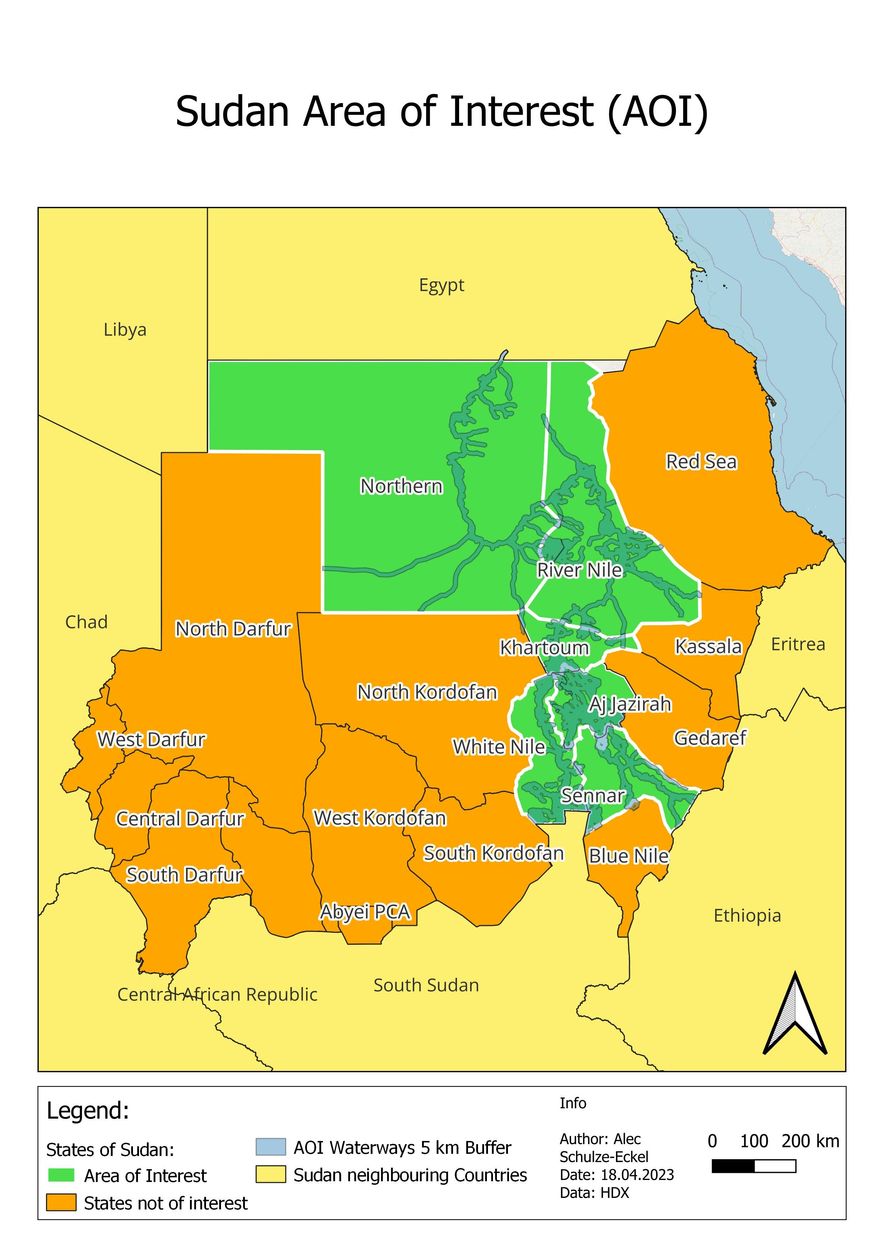
Step 2. Finding Flood Disaster Timeframes#
We want to tie single pieces of information like impacts, to known flood events in Sudan. Thus we first need a comprehensive list of such events. In the case of Sudan, there are two sources, EM-DAT and ReliefWeb. EM-DAT is a disaster database that lists events above a certain severity. ReliefWeb is actually an information platform for humanitarian response. But it has a list of active and past disasters as well. Both databases list the same events for the most part. By comparing the two datasets and only selecting unique events, we receive a list of all significant flood events in Sudan and the timeframes of all events.
EM-Dat lists 21 flood events in Sudan from 2000 to 2024
Relief Web lists 29 events between 1988 and 2024
In total, there were 35 flood events reported between 1988 and 2021 In some cases, the start and end dates cannot precisely be identified. This is not a problem, we only want to have a rough overview about when there have been floods.
Flood Events List
Start Year |
Start Date |
End Date |
|---|---|---|
1988 |
1988-08-06 |
1988-09-15 |
1994 |
1994-09-20 |
1988-10-21 |
1996 |
1996-08-12 |
1996-10-23 |
1998 |
1998-09-04 |
1998-10-15 |
2001 |
2001-08-06 |
2001-09-13 |
2002 |
2002-08-03 |
2002-08-03 |
2003 |
2003-07-28 |
2003-08-21 |
2005 |
2005-08-29 |
2005-09-06 |
2005 |
2005-07-14 |
2005-07-15 |
2006 |
2006-08-13 |
2006-09-26 |
2006 |
2006-08-07 |
2006-08-07 |
2007 |
2007-07-03 |
2007-10-08 |
2009 |
2009-08-16 |
2009-08-26 |
2010 |
2010-07-10 |
2010-07-15 |
2010 |
2010-07-01 |
2010-10-07 |
2012 |
2012-08-01 |
2012-08-12 |
2013 |
2013-08-01 |
2013-08-21 |
2014 |
2014-07-25 |
2014-09 |
2015 |
2015-08-08 |
2015-08-09 |
2017 |
2017-06-30 |
2017-08-14 |
2018 |
2018-06-18 |
2018-06-27 |
2018 |
2018-07-23 |
2018-07-30 |
2019 |
2019-06-08 |
2019-06-18 |
2020 |
2020-06 |
2020-09-09 |
2021 |
2021-07-20 |
2021-09-24 |
Step 3: Selecting datasets#
Now we search for datasets and other information for each of the flood events identified in step 2. Naturally, it will be much easier to find information on more recent events. This process can take a lot of time and sometimes needs multiple iterations.
There are three principal sources of datasets. The Sudan Red Crescent Society (SRCS), ReliefWeb and Floodlist.
Sudan Red Crescent Society (SRCS)
SRCS has documentation about flood impacts and past operations. Furthermore, SRCS was able to source some datasets from the Sudan National Council for Civil Defense (NCCD) and the Sudan Humanitarian Aid Commission (HAC).

ReliefWeb
ReliefWeb is the largest database for humanitarian reports and bulletins. The datasets are very conveniently organized based on specific flood events. This makes it easy to match information with an event.

Flood List
Floodlis is a news portal all about floods. The articles are ordered chronologically.

Of course, much information from the different sources is redundant. A significant part of the work is to sift through the datasets and identify unique information.
Datasets#
We use the term data set to refer to all types of publications from which we can obtain data. In the table below we list typical datasets used in the Sudan HIA. Remember, we can pull all kinds of information out of a dataset. It does not have to be quantitative or in table format or anything like that. It can also be info directly from texts or graphics.
Typical Publishing Organisation (Examples) |
Type |
Example |
Typical Features |
|---|---|---|---|
IFRC |
Emergency Plan of Action |
Tables; Graphics; Maps; Info directly from texts |
|
IFRC |
Flood Interagency Assessment Reports |
Not public |
Tables; Graphics; Maps; Info directly from texts |
IFRC |
Government Datasets |
Not public |
Tables in many different forms |
UN OCHA |
Humanitarian Bulletins |
Sudan Humanitarian Bulletin Issue 18/ 8 October – 4 November 2018 |
Tables; Graphics; Maps; Info directly from texts |
UN OCHA |
(Flood) Situation Reports |
Tables; Graphics; Maps; Info directly from texts |
|
UN OCHA |
Humanitarian Snapshots |
Sudan: Humanitarian Snapshot - September 2021 (as of 18 October 2021) |
Tables; Graphics; Maps; Info directly from texts |
UN OCHA |
Dashboards |
Data in Excel or CSV data format |
|
World Bank |
Large Reports |
Sudan Rapid Post Disaster Needs and Recovery Assessment (Rapid PDNRA) |
Tables; Graphics; Maps; Info directly from texts |
Floodlist |
Newspaper Articles |
Info directly from texts |
Data selection parameters#
In general, we can use any kind of dataset e.g. reports, maps, bulletins, tables…. However, we do not need to check all datasets available for one event. The selection of datasets is based on two principal parameters.
Currentness
The assumption is that later after the event, the picture of what happens becomes clearer, thus the data report is more reliable. This means., if you have multiple similar datasets containing similar data, chose the newer one.
In this example, the later map from the 13th of November shows more affected people for instance in Central Darfur the the map published on the 9th of November.
Uniqueness
It is important to not only use data from one source because of confidence. The assumption is that different organisations have different capacities and work in different areas, thus they may have better information in some locations of sectors than other organisations.
Dataset ID#
When selecting datasets it is important to save the datasets on your computer. To be able to later retrace which piece of information was taken from which datasets, we have to give the datasets unique identification codes.
In the Sudan project, we used the simple structure year of the flood the document is referring to (for example 2019), the publishing organisation (for example IFRC) and the publishing date (for example 20191003).
Step 3: Outcome#
At the end of the selection process, you should have multiple relevant datasets with IDs for every event, covering all relevant areas and sectors.
All datasets with ID used by HeiGIT
2012 |
2013 |
2014 |
2016 |
2017 |
|---|---|---|---|---|
2012_IFRC_20120531.pdf |
2013_Floodlist_20130816.pdf |
2014_Floodlist_20140801.pdf |
2016_IFRC_20160902.pdf |
2017_floodlist_20170825.pdf |
2012_IFRC_20120910.pdf |
2013_Floodlist_20130827.pdf |
2014_Floodlist_20140804.pdf |
2016_OCHA_20160828.pdf |
2017_floodlist_20170829.pdf |
2013_IFRC_20131010.pdf |
2014_Floodlist_20140814.pdf |
2017_floodlist_20170905.pdf |
||
2013_OCHA_20130915.pdf |
2014_Floodlist_20140920.pdf |
2017_floodlist_20170906.pdf |
||
2013_OCHA_20130919.pdf |
2014_IFRC_20140925.pdf |
2017_HAC_20170919.pdf |
||
2013_OCHA_20130930.pdf |
2014_OCHA_20140909.pdf |
|||
2013_OCHA_HAC_20130902.pdf |
2014_OCHA_20140914.pdf |
|||
2014_RelifeWeb_20140915.pdf |
||||
2014_RelifeWeb_20141009.pdf |
||||
2014_SRCS_20140903.pdf |
2018 |
2019 |
2020 |
2021 |
2022 |
Extra |
|---|---|---|---|---|---|
2018_floodlist_20180625.pdf |
2019_ECHO_20190906.pdf |
2020_OCHA_20201025.pdf |
2021_OCHA_20211011.xlsx |
2022_OCHA_20221025.xlsx |
HAC_1_affected.pdf |
2018_floodlist_20181105.pdf |
2019_floodlist_20190613.pdf |
2020_PDNRA_20210531.pdf |
2021_OCHA_20211018.pdf |
Interagency_mission2022.pdf |
|
2018_floodlist_DG_ECHO_20180824.pdf |
2019_floodlist_20190816.pdf |
NCCD_1_Impact.xlsx |
|||
2018_IFRC_20180813.pdf |
2019_floodlist_20190821.pdf |
||||
2018_OCHA_20180819.pdf |
2019_floodlist_20190901.pdf |
||||
2018_OCHA_20181104.pdf |
2019_floodlist_20191008.pdf |
||||
2019_OCHA_20191003.pdf |
|||||
Step 4: Preparing Excel table Structure#
Before we can start compiling data, we need to prepare the table structure we will use. The table needs to accommodate four components. Date, data source, location,and impact information.
Date#
The date information must accommodate the flood event information from the list of flood events prepared in Step 2. And potential dates of specific impact information. The date portion of the whole Excel table would look like this:
Start Year |
Start Date |
End Date |
Date |
|---|---|---|---|
2018 |
2018-07-01 |
2018-08-29 |
2018-07-12 |
2019 |
2019-06-01 |
2019-06-31 |
|
2020 |
2020-07-20 |
2020-08-11 |
Data source#
This section is simply one column with the ID of the dataset from which the particular information was taken.
source_ID |
|---|
2018_OCHA_20180819.pdf |
2019_floodlist_20190613.pdf |
2020_PDNRA_20210531.pdf |
Location#
Practical all impact information refers to state, locality, town or refugee/IDP camp level. This means we need a column for each of these levels and one column to indicate the level the information is referring to. In this way, we can later filter for all information on for example locality level.
admin_level |
admin_1 |
admin_2 |
admin_3 |
admin_camp |
|---|---|---|---|---|
State |
West Kordofan |
|||
Locality |
South Darfur |
Beliel |
||
Camp |
South Darfur |
Beliel |
Kalma Camp |
In the Sudan HIA, most of the information has been on the state level, whereas the team found very little information on the camp level.
Admin_level |
Number of informations |
|---|---|
State |
1,979 |
Locality |
596 |
Town/ Village |
565 |
IDP & Refugee Camp |
63 |
Tip
We highly recommend using the English names of states and localities which are compatible with P-codes. Those can be found here.
Admin 1 - States
ADM1_EN |
ADM1_AR |
ADM1_PCODE |
|---|---|---|
Abyei PCA |
إدارية أبيي |
SD19 |
Aj Jazirah |
الجزيرة |
SD15 |
Blue Nile |
النيل الأزرق |
SD08 |
Central Darfur |
وسط دارفور |
SD06 |
East Darfur |
شرق دارفور |
SD05 |
Gedaref |
القضارف |
SD12 |
Kassala |
كسلا |
SD11 |
Khartoum |
الخرطوم |
SD01 |
North Darfur |
شمال دارفور |
SD02 |
North Kordofan |
شمال كردفان |
SD13 |
Northern |
الشمالية |
SD17 |
Red Sea |
البحر الأحمر |
SD10 |
River Nile |
نهر النيل |
SD16 |
Sennar |
سنار |
SD14 |
South Darfur |
جنوب دارفور |
SD03 |
South Kordofan |
جنوب كردفان |
SD07 |
West Darfur |
غرب دارفور |
SD04 |
West Kordofan |
غرب كردفان |
SD18 |
White Nile |
النيل الأبيض |
SD09 |
Admin 2- Localities
ADM2_EN |
ADM2_AR |
ADM2_PCODE |
ADM1_EN |
ADM1_AR |
ADM1_PCODE |
|---|---|---|---|---|---|
Abassiya |
العباسية |
SD07090 |
South Kordofan |
جنوب كردفان |
SD07 |
Abu Hamad |
أبو حمد |
SD16008 |
River Nile |
نهر النيل |
SD16 |
Abu Hujar |
أبو حجار |
SD14037 |
Sennar |
سنار |
SD14 |
Abu Jabrah |
أبو جابرة |
SD05140 |
East Darfur |
شرق دارفور |
SD05 |
Abu Jubayhah |
أبو جبيهة |
SD07088 |
South Kordofan |
جنوب كردفان |
SD07 |
Abu Karinka |
أبو كارنكا |
SD05155 |
East Darfur |
شرق دارفور |
SD05 |
Abu Kershola |
أبو كرشولا |
SD07104 |
South Kordofan |
جنوب كردفان |
SD07 |
Abu Zabad |
أبو زبد |
SD18028 |
West Kordofan |
غرب كردفان |
SD18 |
Abyei |
أبيي |
SD18087 |
West Kordofan |
غرب كردفان |
SD18 |
Abyei PCA area |
إدارية أبيي |
SD19001 |
Abyei PCA |
إدارية أبيي |
SD19 |
Ad Dabbah |
الدبة |
SD17019 |
Northern |
الشمالية |
SD17 |
Ad Dali |
الدالي |
SD14039 |
Sennar |
سنار |
SD14 |
Ad Damar |
الدامر |
SD16011 |
River Nile |
نهر النيل |
SD16 |
Ad Dinder |
الدندر |
SD14040 |
Sennar |
سنار |
SD14 |
Ad Diwaim |
الدويم |
SD09044 |
White Nile |
النيل الأبيض |
SD09 |
Ad Du’ayn |
الضعين |
SD05142 |
East Darfur |
شرق دارفور |
SD05 |
Adila |
عديلة |
SD05139 |
East Darfur |
شرق دارفور |
SD05 |
Ag Geneina |
الجنينة |
SD04115 |
West Darfur |
غرب دارفور |
SD04 |
Agig |
عقيق |
SD10072 |
Red Sea |
البحر الأحمر |
SD10 |
Aj Jabalain |
الجبلين |
SD09051 |
White Nile |
النيل الأبيض |
SD09 |
Al Buhaira |
البحيرة |
SD16014 |
River Nile |
نهر النيل |
SD16 |
Al Buram |
البرام |
SD07099 |
South Kordofan |
جنوب كردفان |
SD07 |
Al Burgaig |
البرقيق |
SD17016 |
Northern |
الشمالية |
SD17 |
Al Butanah |
البطانة |
SD12073 |
Gedaref |
القضارف |
SD12 |
Al Dibab |
الدبب |
SD18103 |
West Kordofan |
غرب كردفان |
SD18 |
Al Fao |
الفاو |
SD12074 |
Gedaref |
القضارف |
SD12 |
Al Fashaga |
الفشقة |
SD12075 |
Gedaref |
القضارف |
SD12 |
Al Fasher |
الفاشر |
SD02114 |
North Darfur |
شمال دارفور |
SD02 |
Al Firdous |
الفردوس |
SD05152 |
East Darfur |
شرق دارفور |
SD05 |
Al Galabat Al Gharbyah - Kassab |
القلابات الغربية - كساب |
SD12078 |
Gedaref |
القضارف |
SD12 |
Al Ganab |
القنب |
SD10069 |
Red Sea |
البحر الأحمر |
SD10 |
Al Gitaina |
القطينة |
SD09050 |
White Nile |
النيل الأبيض |
SD09 |
Al Golid |
القولد |
SD17018 |
Northern |
الشمالية |
SD17 |
Al Hasahisa |
الحصاحيصا |
SD15034 |
Aj Jazirah |
الجزيرة |
SD15 |
Al Idia |
الأضية |
SD18104 |
West Kordofan |
غرب كردفان |
SD18 |
Al Kamlin |
الكاملين |
SD15035 |
Aj Jazirah |
الجزيرة |
SD15 |
Al Khiwai |
الخوي |
SD18105 |
West Kordofan |
غرب كردفان |
SD18 |
Al Koma |
الكومة |
SD02116 |
North Darfur |
شمال دارفور |
SD02 |
Al Kurmuk |
الكرمك |
SD08106 |
Blue Nile |
النيل الأزرق |
SD08 |
Al Lagowa |
لقاوة |
SD18102 |
West Kordofan |
غرب كردفان |
SD18 |
Al Lait |
اللعيت |
SD02169 |
North Darfur |
شمال دارفور |
SD02 |
Al Leri |
الليري |
SD07105 |
South Kordofan |
جنوب كردفان |
SD07 |
Al Mafaza |
المفازة |
SD12082 |
Gedaref |
القضارف |
SD12 |
Al Malha |
المالحة |
SD02117 |
North Darfur |
شمال دارفور |
SD02 |
Al Manaqil |
المناقل |
SD15036 |
Aj Jazirah |
الجزيرة |
SD15 |
Al Matama |
المتمة |
SD16009 |
River Nile |
نهر النيل |
SD16 |
Al Meiram |
الميرم |
SD18106 |
West Kordofan |
غرب كردفان |
SD18 |
Al Quoz |
القوز |
SD07094 |
South Kordofan |
جنوب كردفان |
SD07 |
Al Qurashi |
القرشي |
SD15037 |
Aj Jazirah |
الجزيرة |
SD15 |
Al Qureisha |
القريشة |
SD12076 |
Gedaref |
القضارف |
SD12 |
Al Radoum |
الردوم |
SD03141 |
South Darfur |
جنوب دارفور |
SD03 |
Al Wihda |
الوحدة |
SD03150 |
South Darfur |
جنوب دارفور |
SD03 |
An Nuhud |
النهود |
SD18022 |
West Kordofan |
غرب كردفان |
SD18 |
Ar Rahad |
الرهد |
SD12084 |
Gedaref |
القضارف |
SD12 |
Ar Rahad |
الرهد |
SD13030 |
North Kordofan |
شمال كردفان |
SD13 |
Ar Rashad |
الرشاد |
SD07093 |
South Kordofan |
جنوب كردفان |
SD07 |
Ar Reif Ash Shargi |
الريف الشرقي |
SD07097 |
South Kordofan |
جنوب كردفان |
SD07 |
Ar Rusayris |
الروصيرص |
SD08107 |
Blue Nile |
النيل الأزرق |
SD08 |
As Salam - SD |
السلام - ج د |
SD03166 |
South Darfur |
جنوب دارفور |
SD03 |
As Salam - WK |
السلام - غ ك |
SD18086 |
West Kordofan |
غرب كردفان |
SD18 |
As Salam / Ar Rawat |
السلام / الراوات |
SD09049 |
White Nile |
النيل الأبيض |
SD09 |
As Serief |
السريف |
SD02118 |
North Darfur |
شمال دارفور |
SD02 |
As Suki |
السوكي |
SD14041 |
Sennar |
سنار |
SD14 |
As Sunta |
السنطة |
SD03156 |
South Darfur |
جنوب دارفور |
SD03 |
As Sunut |
السنوط |
SD18092 |
West Kordofan |
غرب كردفان |
SD18 |
Assalaya |
عسلاية |
SD05163 |
East Darfur |
شرق دارفور |
SD05 |
At Tadamon - BN |
التضامن - ن ق |
SD08108 |
Blue Nile |
النيل الأزرق |
SD08 |
At Tadamon - SK |
التضامن - ج ك |
SD07106 |
South Kordofan |
جنوب كردفان |
SD07 |
At Tawisha |
الطويشة |
SD02119 |
North Darfur |
شمال دارفور |
SD02 |
At Tina |
الطينة |
SD02171 |
North Darfur |
شمال دارفور |
SD02 |
Atbara |
عطبرة |
SD16012 |
River Nile |
نهر النيل |
SD16 |
Azum |
أزوم |
SD06110 |
Central Darfur |
وسط دارفور |
SD06 |
Babanusa |
بابنوسة |
SD18100 |
West Kordofan |
غرب كردفان |
SD18 |
Bahr Al Arab |
بحر العرب |
SD05160 |
East Darfur |
شرق دارفور |
SD05 |
Bahri |
بحري |
SD01003 |
Khartoum |
الخرطوم |
SD01 |
Bara |
بارا |
SD13026 |
North Kordofan |
شمال كردفان |
SD13 |
Barbar |
بربر |
SD16013 |
River Nile |
نهر النيل |
SD16 |
Basundah |
باسندة |
SD12077 |
Gedaref |
القضارف |
SD12 |
Baw |
باو |
SD08104 |
Blue Nile |
النيل الأزرق |
SD08 |
Beida |
بيضا |
SD04111 |
West Darfur |
غرب دارفور |
SD04 |
Beliel |
بليل |
SD03162 |
South Darfur |
جنوب دارفور |
SD03 |
Bendasi |
بندسي |
SD06112 |
Central Darfur |
وسط دارفور |
SD06 |
Buram |
برام |
SD03161 |
South Darfur |
جنوب دارفور |
SD03 |
Damso |
دمسو |
SD03172 |
South Darfur |
جنوب دارفور |
SD03 |
Dar As Salam |
دار السلام |
SD02113 |
North Darfur |
شمال دارفور |
SD02 |
Delami |
دلامي |
SD07107 |
South Kordofan |
جنوب كردفان |
SD07 |
Delgo |
دلقو |
SD17015 |
Northern |
الشمالية |
SD17 |
Dilling |
الدلنج |
SD07095 |
South Kordofan |
جنوب كردفان |
SD07 |
Dongola |
دنقلا |
SD17017 |
Northern |
الشمالية |
SD17 |
Dordieb |
درديب |
SD10063 |
Red Sea |
البحر الأحمر |
SD10 |
Ed Al Fursan |
عد الفرسان |
SD03143 |
South Darfur |
جنوب دارفور |
SD03 |
Ed Damazine |
الدمازين |
SD08105 |
Blue Nile |
النيل الأزرق |
SD08 |
Foro Baranga |
فور برنقا |
SD04121 |
West Darfur |
غرب دارفور |
SD04 |
Gala’a Al Nahal |
قلع النحل |
SD12079 |
Gedaref |
القضارف |
SD12 |
Galabat Ash-Shargiah |
القلابات الشرقية |
SD12083 |
Gedaref |
القضارف |
SD12 |
Gebrat Al Sheikh |
جبرة الشيخ |
SD13027 |
North Kordofan |
شمال كردفان |
SD13 |
Geisan |
قيسان |
SD08109 |
Blue Nile |
النيل الأزرق |
SD08 |
Gereida |
قريضة |
SD03153 |
South Darfur |
جنوب دارفور |
SD03 |
Ghadeer |
غدير |
SD07108 |
South Kordofan |
جنوب كردفان |
SD07 |
Gharb Bara |
غرب بارا |
SD13029 |
North Kordofan |
شمال كردفان |
SD13 |
Gharb Jabal Marrah |
غرب جبل مرة |
SD06131 |
Central Darfur |
وسط دارفور |
SD06 |
Ghubaish |
غبيش |
SD18021 |
West Kordofan |
غرب كردفان |
SD18 |
Guli |
قلي |
SD09052 |
White Nile |
النيل الأبيض |
SD09 |
Habila - SK |
هبيلة - ج ك |
SD07103 |
South Kordofan |
جنوب كردفان |
SD07 |
Habila - WD |
هبيلة - غ د |
SD04122 |
West Darfur |
غرب دارفور |
SD04 |
Hala’ib |
حلايب |
SD10066 |
Red Sea |
البحر الأحمر |
SD10 |
Halfa |
حلفا |
SD17014 |
Northern |
الشمالية |
SD17 |
Halfa Aj Jadeedah |
حلفا الجديدة |
SD11052 |
Kassala |
كسلا |
SD11 |
Haya |
هيا |
SD10070 |
Red Sea |
البحر الأحمر |
SD10 |
Heiban |
هيبان |
SD07096 |
South Kordofan |
جنوب كردفان |
SD07 |
Janub Al Jazirah |
جنوب الجزيرة |
SD15031 |
Aj Jazirah |
الجزيرة |
SD15 |
Jebel Awlia |
جبل أولياء |
SD01001 |
Khartoum |
الخرطوم |
SD01 |
Jebel Moon |
جبل مون |
SD04123 |
West Darfur |
غرب دارفور |
SD04 |
Jubayt Elma’aadin |
جبيت المعادن |
SD10067 |
Red Sea |
البحر الأحمر |
SD10 |
Kadugli |
كادقلي |
SD07098 |
South Kordofan |
جنوب كردفان |
SD07 |
Karrari |
كرري |
SD01005 |
Khartoum |
الخرطوم |
SD01 |
Kas |
كاس |
SD03144 |
South Darfur |
جنوب دارفور |
SD03 |
Kateila |
كتيلا |
SD03159 |
South Darfur |
جنوب دارفور |
SD03 |
Kebkabiya |
كبكابية |
SD02124 |
North Darfur |
شمال دارفور |
SD02 |
Keilak |
كيلك |
SD18085 |
West Kordofan |
غرب كردفان |
SD18 |
Kelemando |
كلمندو |
SD02126 |
North Darfur |
شمال دارفور |
SD02 |
Kereneik |
كرينك |
SD04125 |
West Darfur |
غرب دارفور |
SD04 |
Kernoi |
كرنوي |
SD02168 |
North Darfur |
شمال دارفور |
SD02 |
Khartoum |
الخرطوم |
SD01007 |
Khartoum |
الخرطوم |
SD01 |
Kosti |
كوستي |
SD09047 |
White Nile |
النيل الأبيض |
SD09 |
Kubum |
كبم |
SD03157 |
South Darfur |
جنوب دارفور |
SD03 |
Kulbus |
كلبس |
SD04127 |
West Darfur |
غرب دارفور |
SD04 |
Kutum |
كتم |
SD02128 |
North Darfur |
شمال دارفور |
SD02 |
Madeinat Al Gedaref |
مدينة القضارف |
SD12080 |
Gedaref |
القضارف |
SD12 |
Madeinat Kassala |
مدينة كسلا |
SD11053 |
Kassala |
كسلا |
SD11 |
Medani Al Kubra |
مدني الكبري |
SD15030 |
Aj Jazirah |
الجزيرة |
SD15 |
Melit |
مليط |
SD02129 |
North Darfur |
شمال دارفور |
SD02 |
Mershing |
مرشنج |
SD03145 |
South Darfur |
جنوب دارفور |
SD03 |
Merwoe |
مروي |
SD17020 |
Northern |
الشمالية |
SD17 |
Mukjar |
مكجر |
SD06130 |
Central Darfur |
وسط دارفور |
SD06 |
Nitega |
نتيقة |
SD03151 |
South Darfur |
جنوب دارفور |
SD03 |
Nyala Janoub |
نيالا جنوب |
SD03167 |
South Darfur |
جنوب دارفور |
SD03 |
Nyala Shimal |
نيالا شمال |
SD03164 |
South Darfur |
جنوب دارفور |
SD03 |
Port Sudan |
بورتسودان |
SD10064 |
Red Sea |
البحر الأحمر |
SD10 |
Rabak |
ربك |
SD09046 |
White Nile |
النيل الأبيض |
SD09 |
Rehaid Albirdi |
رهيد البردي |
SD03158 |
South Darfur |
جنوب دارفور |
SD03 |
Reifi Aroma |
ريفى أروما |
SD11055 |
Kassala |
كسلا |
SD11 |
Reifi Gharb Kassala |
ريفى غرب كسلا |
SD11054 |
Kassala |
كسلا |
SD11 |
Reifi Hamashkureib |
ريفى همش كوريب |
SD11058 |
Kassala |
كسلا |
SD11 |
Reifi Kassla |
ريفى كسلا |
SD11056 |
Kassala |
كسلا |
SD11 |
Reifi Khashm Elgirba |
ريفى خشم القربة |
SD11060 |
Kassala |
كسلا |
SD11 |
Reifi Nahr Atbara |
ريفى نهر عطبرة |
SD11062 |
Kassala |
كسلا |
SD11 |
Reifi Shamal Ad Delta |
ريفى شمال الدلتا |
SD11057 |
Kassala |
كسلا |
SD11 |
Reifi Telkok |
ريفى تلكوك |
SD11059 |
Kassala |
كسلا |
SD11 |
Reifi Wad Elhilaiw |
ريفى ود الحليو |
SD11061 |
Kassala |
كسلا |
SD11 |
Saraf Omra |
سرف عمرة |
SD02133 |
North Darfur |
شمال دارفور |
SD02 |
Sawakin |
سواكن |
SD10068 |
Red Sea |
البحر الأحمر |
SD10 |
Sennar |
سنار |
SD14038 |
Sennar |
سنار |
SD14 |
Shamal Jabal Marrah |
شمال جبل مرة |
SD06132 |
Central Darfur |
وسط دارفور |
SD06 |
Sharg Aj Jabal |
شرق الجبل |
SD03147 |
South Darfur |
جنوب دارفور |
SD03 |
Sharg Al Jazirah |
شرق الجزيرة |
SD15033 |
Aj Jazirah |
الجزيرة |
SD15 |
Sharg An Neel |
شرق النيل |
SD01004 |
Khartoum |
الخرطوم |
SD01 |
Sharg Sennar |
شرق سنار |
SD14042 |
Sennar |
سنار |
SD14 |
Shattaya |
شطاية |
SD03154 |
South Darfur |
جنوب دارفور |
SD03 |
Sheikan |
شيكان |
SD13024 |
North Kordofan |
شمال كردفان |
SD13 |
Shendi |
شندي |
SD16010 |
River Nile |
نهر النيل |
SD16 |
Shia’ria |
شعيرية |
SD05148 |
East Darfur |
شرق دارفور |
SD05 |
Sinja |
سنجة |
SD14043 |
Sennar |
سنار |
SD14 |
Sinkat |
سنكات |
SD10071 |
Red Sea |
البحر الأحمر |
SD10 |
Sirba |
سربا |
SD04134 |
West Darfur |
غرب دارفور |
SD04 |
Soudari |
سودري |
SD13025 |
North Kordofan |
شمال كردفان |
SD13 |
Talawdi |
تلودي |
SD07089 |
South Kordofan |
جنوب كردفان |
SD07 |
Tawila |
طويلة |
SD02170 |
North Darfur |
شمال دارفور |
SD02 |
Tawkar |
طوكر |
SD10065 |
Red Sea |
البحر الأحمر |
SD10 |
Tendalti |
تندلتي |
SD09048 |
White Nile |
النيل الأبيض |
SD09 |
Tulus |
تلس |
SD03149 |
South Darfur |
جنوب دارفور |
SD03 |
Um Algura |
أم القري |
SD15032 |
Aj Jazirah |
الجزيرة |
SD15 |
Um Bada |
أمبدة |
SD01002 |
Khartoum |
الخرطوم |
SD01 |
Um Baru |
أم برو |
SD02120 |
North Darfur |
شمال دارفور |
SD02 |
Um Dafoug |
أم دافوق |
SD03146 |
South Darfur |
جنوب دارفور |
SD03 |
Um Dam Haj Ahmed |
أم دم حاج أحمد |
SD13028 |
North Kordofan |
شمال كردفان |
SD13 |
Um Dukhun |
أم دخن |
SD06135 |
Central Darfur |
وسط دارفور |
SD06 |
Um Durein |
أم دورين |
SD07091 |
South Kordofan |
جنوب كردفان |
SD07 |
Um Durman |
أم درمان |
SD01006 |
Khartoum |
الخرطوم |
SD01 |
Um Kadadah |
أم كدادة |
SD02136 |
North Darfur |
شمال دارفور |
SD02 |
Um Rawaba |
أم روابة |
SD13023 |
North Kordofan |
شمال كردفان |
SD13 |
Um Rimta |
أم رمتة |
SD09045 |
White Nile |
النيل الأبيض |
SD09 |
Wad Al Mahi |
ود الماحي |
SD08110 |
Blue Nile |
النيل الأزرق |
SD08 |
Wad Bandah |
ود بندة |
SD18029 |
West Kordofan |
غرب كردفان |
SD18 |
Wadi Salih |
وادي صالح |
SD06137 |
Central Darfur |
وسط دارفور |
SD06 |
Wasat Al Gedaref |
وسط القضارف |
SD12081 |
Gedaref |
القضارف |
SD12 |
Wasat Jabal Marrah |
وسط جبل مرة |
SD06139 |
Central Darfur |
وسط دارفور |
SD06 |
Yassin |
يس |
SD05165 |
East Darfur |
شرق دارفور |
SD05 |
Zalingi |
زالنجى |
SD06138 |
Central Darfur |
وسط دارفور |
SD06 |
Impact information#
The actual impact information consists of two parts. One part is always the impact type. This explain what happened. For example, people were affected by the flood, the cholera broke out or schools got damaged.
The other part is either the impact quantity or the impact quality. It can not be both! The impact quantity describes simply how many of something. How many people have been affected? How many schools got damaged?
The impact quality is used if something cannot be described with numbers but with “Yes” or “No”. For example, there was a disease outbreak of cholear. Cholera is not a number. Yes there was cholera outbreak. Or a locality was affected -> Yes the locality was affected.
Hence we need three columns to describe impacts: impact_typ, impact_quality and impact_quantity.
impact_typ |
impact_quality |
impact_quantity |
|---|---|---|
houses_damaged_totaly |
2500 |
|
deaths |
6 |
|
disease_cholera |
yes |
It makes sense to list some of the basic impact types we are interested in or which are very commonly reported. Such as affected people or deaths. The list of impact types can be extended on the fly. It is however important to stay consistent. The HeiGIT team used 75 different impact types. You can find the whole list below.
Impact taypes used in Sudan HIA
Impact Type |
Description |
|---|---|
Affected |
|
Agricultural_land_affected |
|
Agriculturalsectors_fedan |
|
Agriculture_Affected |
|
Agriculture_Bananplantation_damged_totally |
|
Agriculture_crops_damaged |
|
Agriculture_Livestock_crops_damaged |
|
Deaths |
|
Diseases |
|
Economic |
|
Evacuation |
|
Event |
|
Eviromental_sanitation |
|
Flooding |
|
Foodprice_increas |
|
Healt_center_affected |
|
Health_damaged_partially |
|
Health_damaged_totally |
|
HH_Affected |
|
HH_displaced |
|
Houses_damaged_partially |
|
Houses_damaged_totally |
|
Infrastructure_damaged_partially |
|
Infrastructure_electricity_damaged_partially |
|
Injuries |
|
Institutions_damaged_partially |
|
Institutions_damaged_totally |
|
Livestock_Cattle |
|
Livestock_Deaths |
|
Livestock_Goats |
|
Livestock_Poultry |
|
Livestock_Sheep |
|
Mosques_damaged_partally |
|
Mosques_damaged_totally |
|
Mosquitos |
|
Others |
|
Pop_affected |
|
Pop_displaced |
|
Problem_Health_access |
|
Problem_Water_access |
|
Protection_Issus |
|
Public_facilities_damaged_partially |
|
Public_facilities_damaged_totally |
|
Public_facilities_damged_partially |
|
Public_facilities_damged_totally |
|
Public_facilities_schools_affected |
|
Sanitation_partially |
|
School_dropout |
|
Schools_affeacted |
|
Schools_damaged_partially |
|
Schools_damaged_totally |
|
Schools_Primary_damaged_partially |
|
Schools_Primary_damaged_totally |
|
Schools_Secondary_damaged_partially |
|
Schools_Universities_damaged_partially |
|
Shelter |
|
Shops_damaged_partally |
|
Shops_damaged_totally |
|
Villages_affacted |
|
WASH_damaged_partally |
|
WASH_damaged_totally |
|
WASH_drinking_river |
|
WASH_home_latrines_damaged_partially |
|
WASH_latriens_damaged_totally |
|
WASH_latrines_affected |
|
WASH_latrines_damaged_partially |
|
WASH_latrines_damaged_partially |
|
WASH_Latrines_damaged_totally |
|
WASH_latrines_damaged_totaly |
|
WASH_open_defecation |
|
WASH_sewage_damaged_totally |
|
WASH_Water_station_affected |
|
WASH_Water_station_source_damaged_partially |
|
WASH_Water_station_source_damaged_totally |
|
WASH_watersource_contaminated |
Step 4: Outcome#
Now we have your final table structure. We can put ALL information from the selected datasets we deem relevant into this table structure thus creating a consistent historical impact dataset.
Start Year |
Start Date |
End Date |
Date |
source_ID |
admin_level |
admin_1 |
admin_2 |
admin_3 |
admin_camp |
impact_typ |
impact_quality |
impact_quantity |
|---|---|---|---|---|---|---|---|---|---|---|---|---|
2018 |
2018-07-01 |
2018-08-29 |
2018-07-12 |
2018_OCHA_20180819.pdf |
State |
West Kordofan |
disease_outbreak |
Cholera |
||||
2019 |
2019-06-01 |
2019-06-31 |
2019_floodlist_20190613.pdf |
Locality |
South Darfur |
Beliel |
deaths |
6 |
||||
2020 |
2020-07-20 |
2020-08-11 |
2020_PDNRA_20210531.pdf |
Camp |
South Darfur |
Beliel |
Kalma Camp |
houses_damaged_totaly |
2500 |
|||
Step 5: Data compiling#
During the data compilation, we simply identify the relevant information in the dataset and transfer it into the table. Below you can find some examples of the process.
Emergency Plan of Action (EPoA) Sudan: Floods 2018
This is a small extract from Emergency Plan of Action (EPoA) Sudan: Floods 2018 page 4.

Data extracted from dataset
Year |
Start_Date |
End_Date |
Date |
source_ID |
admin_level |
admin_1 |
admin_2 |
admin_3 |
admin_camp |
Impact type |
Impact_quantity |
Impact_quality |
|---|---|---|---|---|---|---|---|---|---|---|---|---|
2018 |
23/07/2018 |
30/07/2018 |
23/07/2018 |
2018_IFRC_20180813 |
Locality |
West Kordofan |
Elnohoud |
houses damaged_totaly |
2500 |
|||
2018 |
23/07/2018 |
30/07/2018 |
23/07/2018 |
2018_IFRC_20180813 |
Locality |
West Kordofan |
Einhoud |
houses_damaged_partially |
1500 |
|||
2018 |
23/07/2018 |
30/07/2018 |
23/07/2018 |
2018_IFRC_20180813 |
State |
West Kordofan |
deaths |
6 |
||||
2018 |
23/07/2018 |
30/07/2018 |
23/07/2018 |
2018_IFRC_20180813 |
State |
West Kordofan |
missing people |
3 |
||||
2018 |
23/07/2018 |
30/07/2018 |
23/07/2018 |
2018_IFRC_20180813 |
State |
West Kordofan |
Injured |
49 |
||||
2018 |
23/07/2018 |
30/07/2018 |
23/07/2018 |
2018_IFRC_20180813 |
State |
West Kordofan |
livestock deaths |
121 |
||||
2018 |
23/07/2018 |
30/07/2018 |
23/07/2018 |
2018_IFRC_20180813 |
State |
West Kordofan |
water infrastructure_damage |
3 |
SUDAN FLOOD RESPONSE HUMANITARIAN PARTNERS UPDATE BY STATE #3 (as of 19 Oct, 2020)
The map on the first page shows affecte population per state. This information can be extracted.
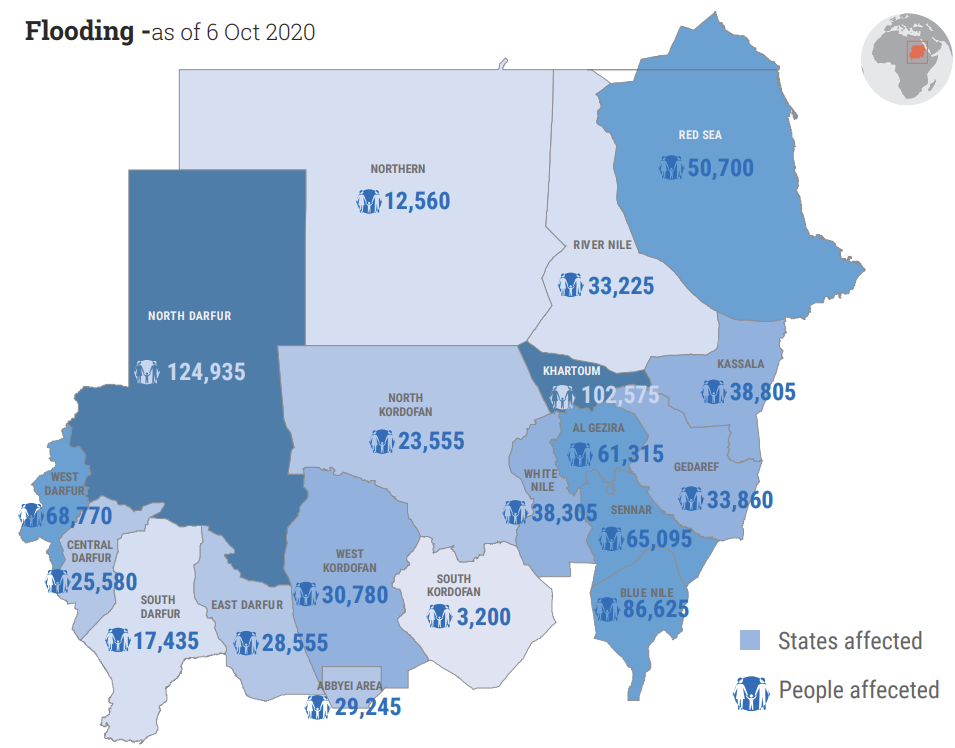
Data extracted from dataset
Year |
Start_Date |
End_Date |
Date |
source_ID |
admin_level |
admin_1 |
admin_2 |
admin_3 |
admin_camp |
Impact type |
Impact_quantity |
Impact quality |
|---|---|---|---|---|---|---|---|---|---|---|---|---|
2020 |
07/2020 |
09/2020 |
2020 OCHA 20201025 |
State |
Northern |
pop_affected |
125660 |
|||||
2020 |
07/2020 |
09/2020 |
2020 OCHA 20201025 |
State |
River Nile |
pop_affected |
33225 |
|||||
… |
… |
… |
… |
… |
… |
… |
… |
… |
… |
… |
… |
Humanitarian Bulletin Sudan Issue 35 | 22 - 28 August 2016

Data extracted from dataset
Year |
Start_Date |
End_Date |
Date |
source_ID |
admin_level |
admin_1 |
admin_2 |
admin_3 |
admin_camp |
Impact type |
Impact_quantity |
Impact quality |
|---|---|---|---|---|---|---|---|---|---|---|---|---|
2016 |
06/2016 |
09/2016 |
2016 OCHA 20160828 |
State |
Kassala |
affected |
yes |
|||||
2016 |
06/2016 |
09/2016 |
2016 OCHA 20160828 |
State |
South Darfur |
affected |
yes |
|||||
2016 |
06/2016 |
09/2016 |
2016 OCHA 20160828 |
State |
Al Gezira |
affected |
yes |
|||||
2016 |
06/2016 |
09/2016 |
2016 OCHA 20160828 |
State |
Sennar |
affected |
yes |
|||||
… |
… |
… |
… |
… |
… |
… |
… |
… |
… |
… |
… |
… |
Sudan Floods Countinue (FloodList)
The quote below is just one bit of relevant information from the flood list article.

Data extracted from dataset
Year |
Start_Date |
End_Date |
Date |
source_ID |
admin_level |
admin_1 |
admin_2 |
admin_3 |
admin_camp |
Impact type |
Impact_quantity |
Impact quality |
|---|---|---|---|---|---|---|---|---|---|---|---|---|
2013 |
01/08/2013 |
21/08/21 |
11/08/2013 |
2013 Floodlist 201308 |
Camp |
South Darfur |
Bellel |
Kalma Camp |
deaths |
14 |
||
2014 |
01/08/2014 |
21/08/22 |
11/08/2014 |
2014 Floodlist 201308 |
Camp |
South Darfur |
Bellel |
Kalma Camp |
houses_damaged_totaly |
874 |
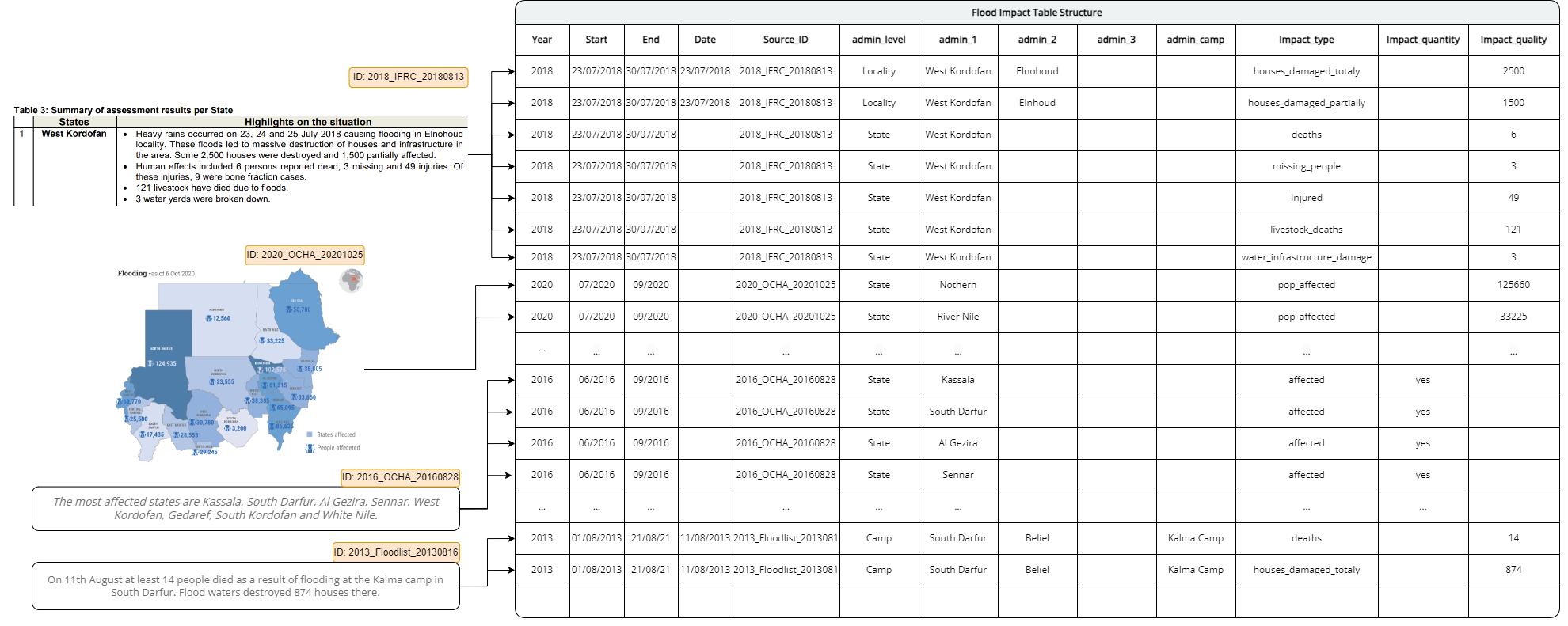
Tipps for data compiling
Compiling the data in EXCEL is a time-intensive and repeatable task. Here are some tips to speed up the process:
Excel copy function:
Try to use the copy function of Excel as much as possible. When taking info from a map, the information in the columns, year, start_date, end_date, date, Source_ID, and admin_level usually stay the same. So you can just copy and paste this information. In most cases, you should only write the name of location, Impact_type, Impact_quality and Impact_quantity.
Use ChatGPT:
If you encounter tables that do not fit into your table structure use ChatGPT to turn them into a long table format. For example, look at the image in the table below.
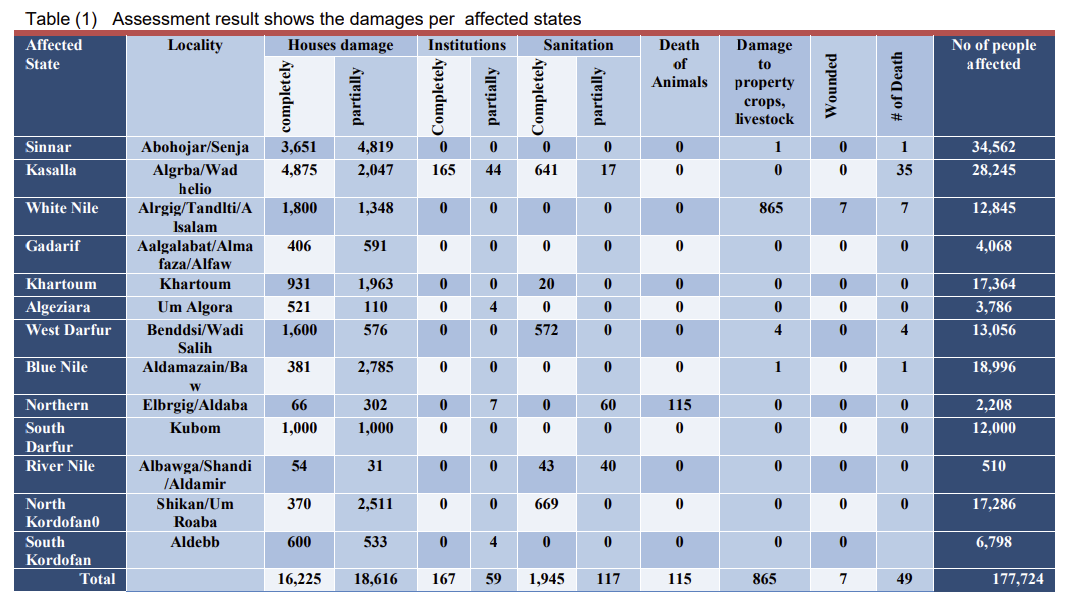
You can copy the content which produces this text:
DREF Final Report Sudan: Floods 31 May 2013
Affected
State
Locality Houses damage Institutions Sanitation Death
of
Animals
Damage
to
property
crops,
livestock
Wounded
of Death
No of people
affected
completely
partially
Completely
partially
Completely
partially
Sinnar Abohojar/Senja 3,651 4,819 0 0 0 0 0 1 0 1 34,562
Kasalla Algrba/Wad
helio
4,875 2,047 165 44 641 17 0 0 0 35 28,245
White Nile Alrgig/Tandlti/A
lsalam
1,800 1,348 0 0 0 0 0 865 7 7 12,845
Gadarif Aalgalabat/Alma
faza/Alfaw
406 591 0 0 0 0 0 0 0 0 4,068
Khartoum Khartoum 931 1,963 0 0 20 0 0 0 0 0 17,364
Algeziara Um Algora 521 110 0 4 0 0 0 0 0 0 3,786
West Darfur Benddsi/Wadi
Salih
1,600 576 0 0 572 0 0 4 0 4 13,056
Blue Nile Aldamazain/Ba
w
381 2,785 0 0 0 0 0 1 0 1 18,996
Northern Elbrgig/Aldaba 66 302 0 7 0 60 115 0 0 0 2,208
South
Darfur
Kubom 1,000 1,000 0 0 0 0 0 0 0 0 12,000
River Nile Albawga/Shandi
/Aldamir
54 31 0 0 43 40 0 0 0 0 510
North
Kordofan0
Shikan/Um
Roaba
370 2,511 0 0 669 0 0 0 0 0 17,286
South
Kordofan
Aldebb 600 533 0 4 0 0 0 0 0 6,798
Total 16,225 18,616 167 59 1,945 117 115 865 7 49 177,724
Go to ChatGPT and use a prompt like „Can you turn this information taken from a Table into a long table format?“ + the table as text
Probably you will have to ask ChatGPT to give you the whole table. Something like: “Super good! Can you give me a table on the other states as well? “
Use Gemini AI:
Google Gemini Can also handle images. For example, it can turn this graph into a table which is much easier to handle than copying everything by hand.
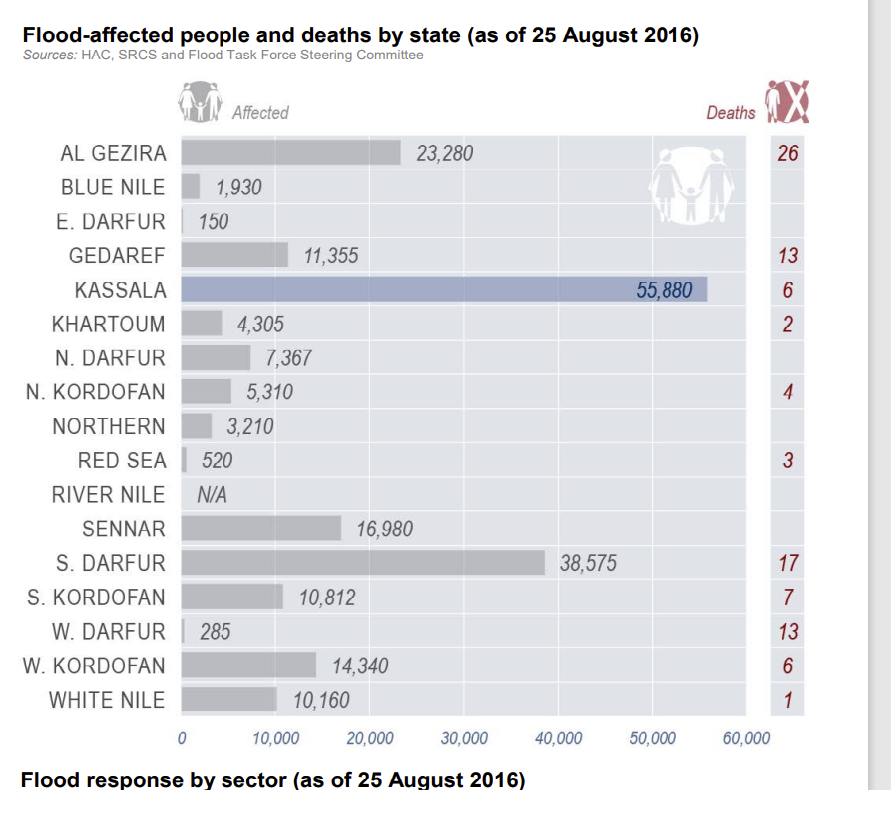
The resulting table can easily be adjusted in Excel.
State |
Affected People |
Deaths |
|---|---|---|
AL GEZIRA |
23,280 |
26 |
BLUE NILE |
1,930 |
- |
E. DARFUR |
150 |
- |
GEDAREF |
11,355 |
13 |
KASSALA |
55,880 |
6 |
KHARTOUM |
4,305 |
2 |
N. DARFUR |
7,367 |
- |
N. KORDOFAN |
5,310 |
4 |
NORTHERN |
3,210 |
- |
RED SEA |
520 |
3 |
RIVER NILE |
N/A |
- |
SENNAR |
16,980 |
- |
S. DARFUR |
38,575 |
17 |
S. KORDOFAN |
10,812 |
7 |
W. DARFUR |
285 |
13 |
W. KORDOFAN |
14,340 |
6 |
WHITE NILE |
10,160 |
1 |
Step 6: HIA Data Cleaning#
When creating such a dataset there will be errors like misspellings of names or wrong numbers. To address that you will need to clean the dataset before actually using it. To clean the dataset you can use Excel or specialized tools like OpenRefine.
Tip
OpenRefine OpenRefine is a free and open-source specialized data cleaning software. You download once the folder with the installation files. To start OpenRefine you need to double-click openrefine.exe. The software will run in your browser! -> Installation Video
OpenRefine Beginner Tutorials -> Video
Independent of which tool you will use, here are some important points you have to check when cleaning the data:
Year and Columns:
Check if all values are within the expected range of years.
Ensure that there are no missing or invalid year values becaus we need a year information for all data
OpenRefine Step: Use the “Text facet” or “Numeric facet” to explore the distribution of values in the Year column. Use the “Text filter” or “Numeric filter” to filter out any rows with invalid or missing year values.
Date Columns (Start_Date, End_Date, Date):
Check if all dates are in the correct date format.
Ensure that there are no inconsistent date values.
OpenRefine Step: Use the “Edit cells” > “Common transforms” > “To date” option to convert date columns to a standard date format. Use the “Text facet” to identify and correct any inconsistencies in formatting or missing dates.
source_ID Column:
Check that there is only one way of spelling for every individual source_ID!
Check if all source IDs follow a consistent naming convention.
Ensure that there are no missing source IDs.
OpenRefine Step: Use the “Text facet” to explore the distribution of values in each admin level column. Click on
Clusterand setMethodtoKey collisionorNearest neighbor. Adjust wrong names by checkingMergeand adjust theNew cell valueand click onMerge selected & re-cluster
Admin Columns (admin_level, admin_1, admin_2, admin_3, admin_camp):
Check if all administrative units are correctly categorized.
Ensure that there are no misspelled or inconsistent administrative unit names.
OpenRefine Step: Use the “Text facet” to explore the distribution of values in each admin level column. Click on
Clusterand setMethodtoKey collisionorNearest neighbor. Consolidate the of states and loclities that they are consisten with the list in the location chapter.Adjust wrong names by checkingMergeand adjust theNew cell valueand click onMerge selected & re-cluster
Impact Type Column:
Check if all impact types are correctly categorized and named.
Ensure that there are no duplicate or missing impact types.
OpenRefine Step: Use the “Text facet” to explore the distribution of values in each admin level column. Click on
Clusterand setMethodtoKey collisionorNearest neighbor. Adjust wrong names by checkingMergeand adjust theNew cell valueand click onMerge selected & re-cluster
Impact Quantity Columns:
Check if all numerical values are within expected ranges.
Ensure that there are no missing or invalid numerical values.
OpenRefine Step: Use the “Numeric facet” to explore the distribution of values in each numerical column. Use the “Edit cells” or “Transform” option to handle missing or invalid values, and standardize formatting.
Impact Quality Columns:
Check that the same impacts are spelt consistently. For example illness names.
OpenRefine Step: Use the “Text facet” to explore the distribution of values in each admin level column. Click on
Clusterand setMethodtoKey collisionorNearest neighbor. Adjust wrong names by checkingMergeand adjust theNew cell valueand click onMerge selected & re-cluster
Delete redundant data
It might be the case that you have for one flood event, multiple information on for example affected populations for the same location. This could later be a problem when you want to analyse the data. Probably, the reddened information is from two different sources. So you can delete the information of the older source and only keep the one from the up-to-date source as possible.
Step 7: Adding P-Codes to the table#
Create a new empty Excel file and name it Sudan_impact_p_code.
Open the new Excel file and click on the Data tab. Click on Data -> Get Data -> From File -> From Excel Workbook and select your cleaned impact data file from the previous section HIA Data Cleaning. We will enrich the information of this table by adding the P-Codes.
The Navigator Window will open. Select the relevant Excel sheet. Click on the drop-down menu Load -> Load To.... The Import Data Window will open. Here select Only Create Connection.
Repeat the previous two steps for the file sdn_adminboundaries_tabulardata.xlsx. Select the sheet ADM1. The data can be downloaded from HDX containing the Subnational Administrative Boundaries of Sudan. Here we can find information about the different administrative levels of Sudan beginning with 0 (country), 1 (state), and 2 (district). Make sure to download the xlsx file.
Once you have loaded both files you should see the Queries & Connections panel on the right-hand side of your Excel. The panel should show the impact sheet and the ADM1 sheet.
Now, click on the Data tab -> Get Data -> Combine Queries -> Merge. The window Merge should open.
In the Merge window, select the admin_1 column for the impact dataset and the ADM1_EN for the ADM1 table. Click on these columns to mark them green.
Under Join Kind select Left Outer (all from first, matching from second). This will take all rows from the impact dataset and the matching data from the ADM1 table. The information below should show a green check and The selection matches [number of rows] of [number of rows] rows from the first table. If not, some of your state names are not consistent with the ones in the ADM1 file. In this case, you would need to do more data cleaning and make sure that naming conventions are met. Click Ok.
The new window Merge1 – Power Query Editor will open. Click on the icon next to ADM1 (column header). Select only the columns you want to keep. We recommend to only keep ADM1_EN and most importantly ADM1_PCODE. Uncheck Use original column names as prefix and click OK.
The table preview should now show your entire impact table with the columns ADM1_EN and ADM1_PCODE on the right end of the table. Click on Close & Load.
The result should be in the Excel file Sudan_impact_p_code. The file should contain all the information from the original impact table and the two new columns ADM1_EN and ADM1_PCODE with this important information for later operations.
Video: How to combine Workbooks using Excel
Step 8: Data export from Excel to QGIS#
Now we have our impact dataset cleaned and ready to use. Since the dataset is a long table we cannot use it as a normal table in Excel. To get the data in a format so we can use it in QGIS or create a graph out of it, we need to pivot it. Depending on your work with impact quantity or quality, there are small differences. Here is how you do it:
Impact Quantity for one year on state level:#
Open the Excel dataset.
Turn the data in a table by clicking on
Insert->Table-> checkMy table has headersAlso under the
Insert-Tab click onPivot Table. Make sure your table range is correct. CheckNew Worksheet. ClickOK.Setup the pivot table by placing the columns as follows:
Filter: Start_year
Columns: Impact_Type
Rows: admin_1 or admin_1_PCODE (If you want to use this table in QGIS, you should use admin_1_PCODE Instead of admin_1)
Values: Impact_quantity
To see the sum of the different impacts click on Impact_quantity under Values ->
Value Field Settings-> selectSum.Directly above the pivot table, you should see the option to filter by year. Select the year you are interested in. For the following example the year 2020 was used.
Now you can just copy the whole table, and place it in a new worksheet. Make sure to only paste the values. Save this output as a CSV-file, this will make the import of the subset into QGIS easier. Now we can use this table to join it with an existing geodataset in QGIS.
Step 9: Data analysis in QGIS#
Visualise impact quantity data for one year on state level in QGIS#
Import the previously created CSV file into QGIS. Open the
Data Source Managerand select theDelimited Textsection. Here you can input your CSV-file and depending on theFile Formatyou need to define Costum delimiters or you can just select CSV. Always check the Sample Data output at the bottom to see if the import is working as expected. You propably will also need to check theRecord and Fields Optionsand specify if your first record is a header or already data. Lastly, it is important to specify theGeometry Definition, were you can just selectNo geometry. An example will be shown in Fig. 135.
Note
To ensure easy data import into QGIS, export the filtered long table data as a CSV file.
Fig. 126 Import of the CSV data#
For this example we will use geodata that contains information about the states of Sudan. Make sure that your geodata has the admin_1_PCODE column that will be used for joining the table data with the geodata. We will use the tool
Join attributes by field value. And select the corresponding columns. This is shown in Fig. 136 below.
Fig. 127 Join the table information onto the geodata#
The information can now be visualized on a spatial scale and maps can be created to transport important information. An example could be to visualize the total affected population for the year of 2020 on state level. But we can also visualize more specific impact types such as damaged schools or damaged sanitation. This is how such a map could look like.
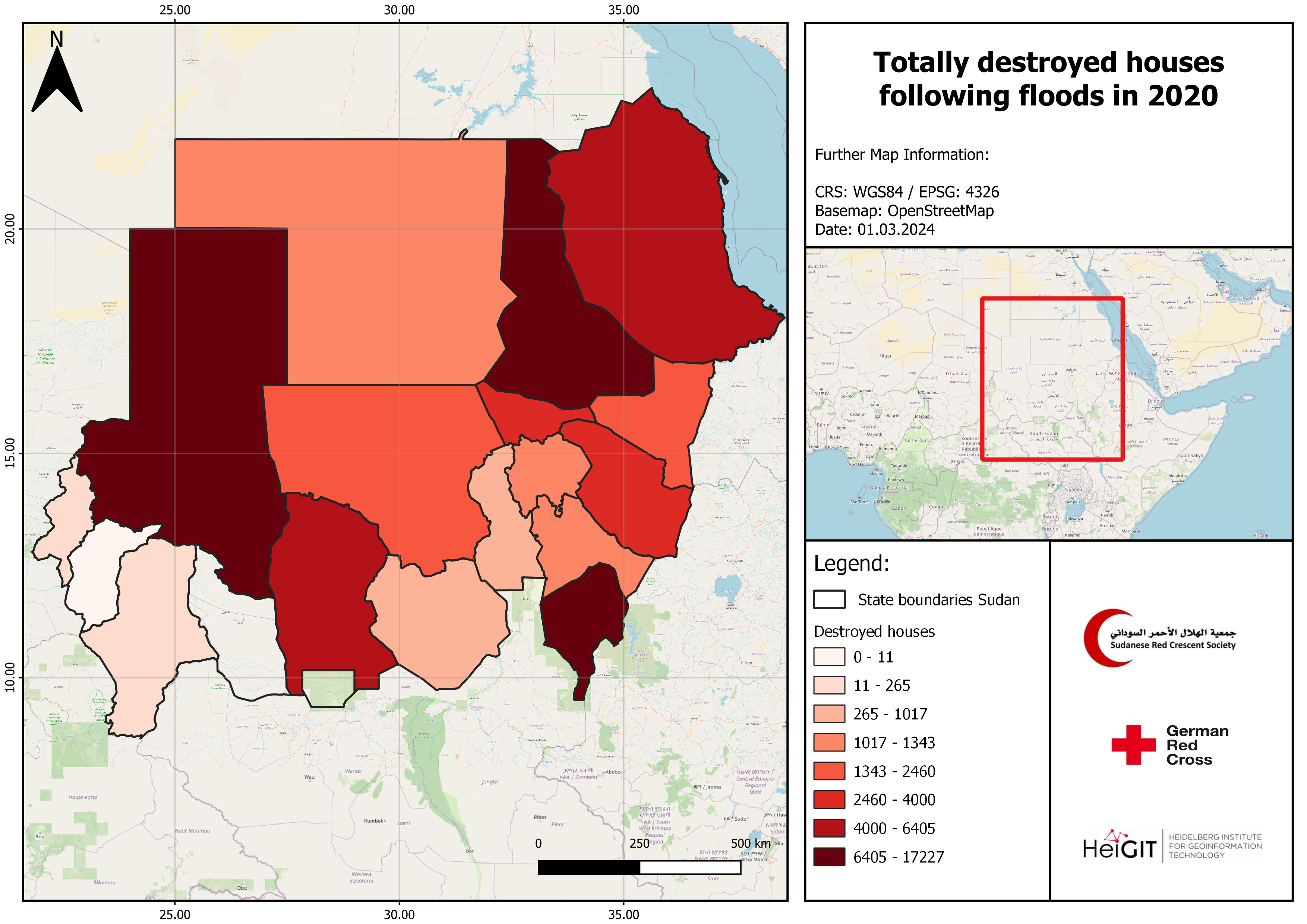
Fig. 128 Example map#
Flood events in Sudanese states for all the recorded years#
In this section we want to analyse and visualise all recorded flooding events for all the Sudanese state. With our filter for the Impact-Type we derive information for the years 2003 until 2021.
In the first step we will create a new
pivot tableand store it in a new sheet. Here we will specify the following:
Columns: Impact_Type
Rows: admin_1_PCODE
Values: Count of impact_quality
Now we want to filter the columns labels to the following impact types:
Event
Flash-flood
Flood
Flooding
We also want to include the Event and Flash-floods as these types can also be associated with flooding events as a result of heavy rainfall, seasonal rainfall, etc.
We also want to make sure that we rename the column containing the sum of the flooding events to Sum flood events.
Now we export this excel sheet as a CSV file and import it into QGIS. We will open the
Data Source Managerand select theDelimited Textsection. Here we need to do the following specifications (Fig. 138).
Note
Always check the Sample Data window to see what your data looks like. These specifications may not always be applicable to your data, and you may need to make minor adjustments.
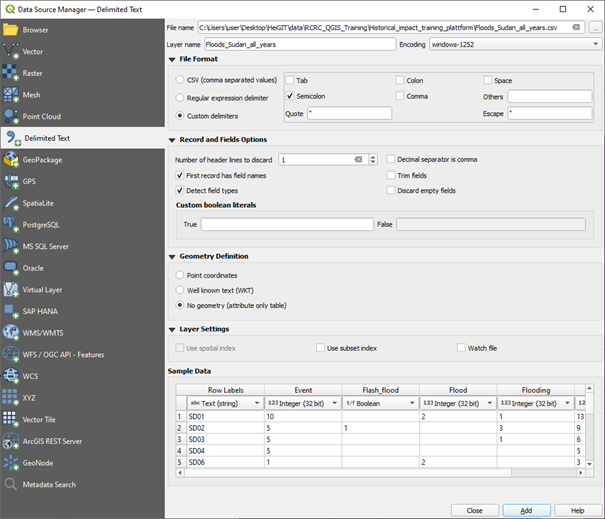
Fig. 129 Import of the CSV data#
The next step follows the same logic as step 2 in the previous example. We will use geodata that contains information about the states of Sudan and join them with the imported CSV data. We will use the
Join attributes by field valuetool and select the ADM1_PCODE as the table field used for the join. An example is shown in Fig. 139.
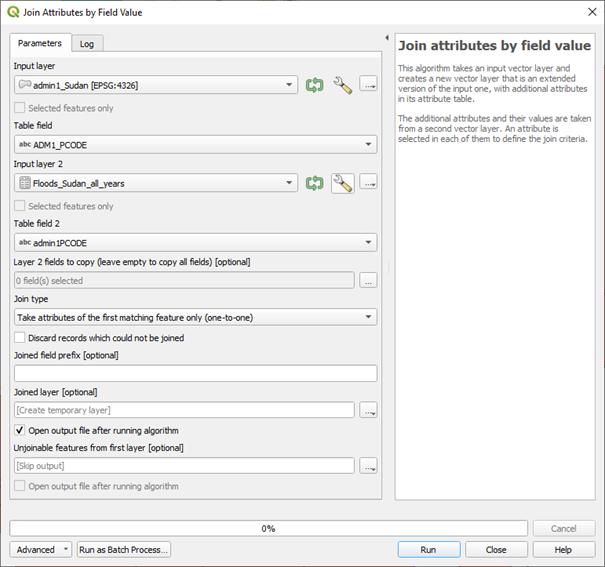
Fig. 130 Join the table information onto the geodata#
Now we can visualise our results using
Graduatedand selecting the corresponding column of the attribute tableSum flood events. Select an appropriate color scheme and start creating your map. Your final product could look like Fig. 140.
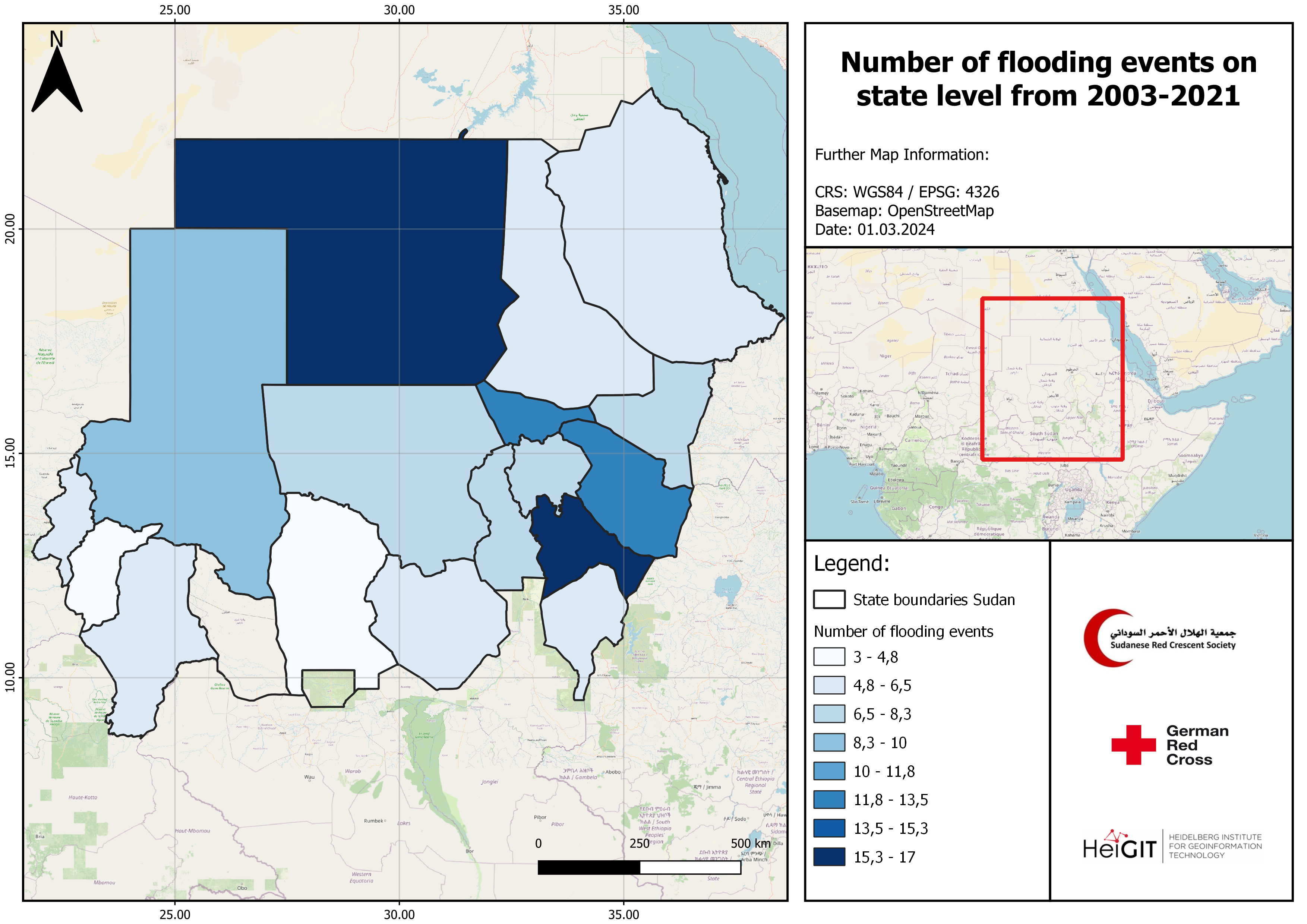
Fig. 131 Example map#
We can expand this analysis by also including the affected population an calculate the average number of affected population per flood event on state level.
We continue with creating a new
pivot table. We will do the following specifications:
Columns: Impact_Type
Rows: admin_1_PCODE
Values: Sum of Impact_quantity
Again we will apply a filter to the column labels and select the impact type Pop_affected. Also make sure to rename the Grand total to Sum affected pop. Export the subset as a CSV file.
The next steps in QGIS will follow the same logic as before. Import the data and join the table onto your output from the previous task. This will look the following Fig. 132.
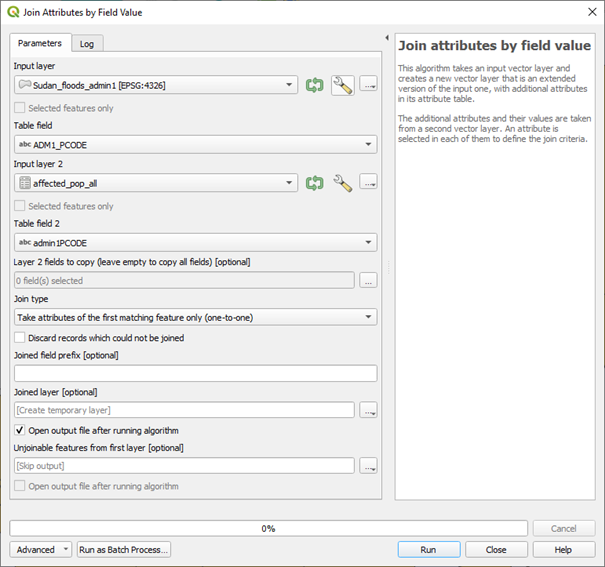
Fig. 132 Join the table information onto the geodata with the flood information.#
Now we will calculate the the average number of affected population per flood event on state level. To do so, we need to activate the editing mode for our geodata clicking on this symbol
 . In the next step we will open the
. In the next step we will open the Field calculator . Here we will calculate the sum of the affected population divided by the number of flood events for each state. Your calculation will look like Fig. 133.
. Here we will calculate the sum of the affected population divided by the number of flood events for each state. Your calculation will look like Fig. 133.
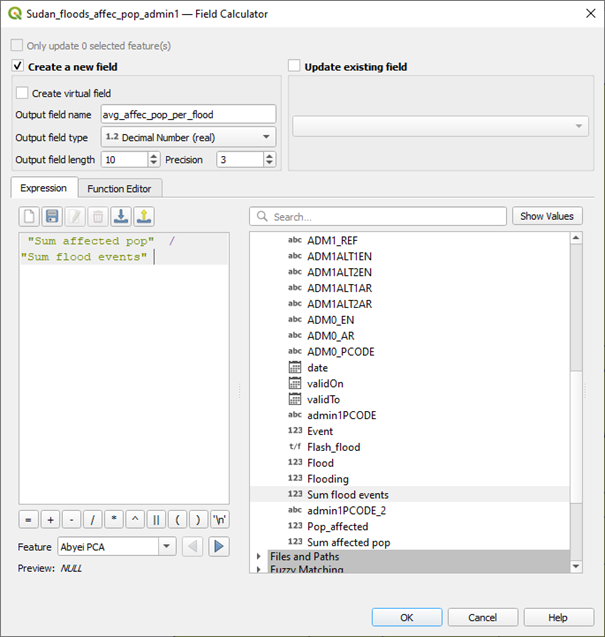
Fig. 133 Calculate the average number of affected population per flood event on state level.#
Visualise the results and create a map.
Note
Two states have NULL values and will not appear when styling the data. The original admin1 Sudan dataset can be used as a mask with the correct styling to include them in our map. This way, we can display the state boundaries without adding any new content.

Fig. 134 Example map#

